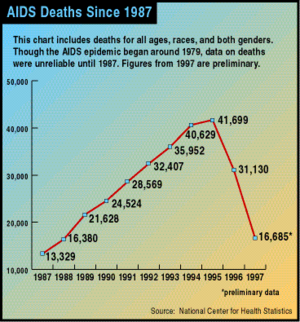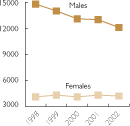HIV/AIDS in the United States
The AIDS epidemic, caused by HIV (Human Immunodeficiency Virus), found its way to the United States between the 1970s and 1980s,[2] but was first noticed after doctors discovered clusters of Kaposi's sarcoma and pneumocystis pneumonia in homosexual men in Los Angeles, New York City, and San Francisco in 1981.
[6][17] Anyone seeking US citizenship during the HIV ban was required to undergo a medical exam during the legalization process - testing positive would permanently deny the applicant entry into the country.
[20] In early December 2006, President George W. Bush indicated that he would issue an executive order allowing HIV positive people to enter the United States on standard visas.
New impetus was added to repeal efforts when Paul Thorn, a UK tuberculosis expert who was invited to speak at the 2009 Pacific Health Summit in Seattle, was denied a visa due to his HIV positive status.
A letter written by Mr. Thorn, and read in his place at the Summit, was obtained by Congressman Jim McDermott, who advocated the issue to the Obama administration's Health Secretary.
[22] On October 30, 2009, President Barack Obama reauthorized the Ryan White HIV/AIDS Bill which expanded care and treatment through federal funding to nearly half a million.
[26] In Vancouver, the 11th International AIDS Conference highlighted the effectiveness highly active antiretroviral therapy (HAART), thus creating a new period of optimism.
[32] In February 2019, U.S. District Court Judge Leonie Brinkema issued an temporary order barring the U.S. military for discharging or denying officer commissions to personnel based on HIV status.
In 1987, Les Pappas, an educator from the San Francisco AIDS Foundation (SFAF), spoke at a conference encouraging gay and bisexual men to use condoms during sexual intercourse.
[36] During the HIV/AIDS epidemic of the 1980s, LGBTQ+ communities were further stigmatized as they became the focus of mass hysteria, suffered isolation and marginalization, and were targeted with extreme acts of violence in the United States.
[39] One of the best known works on the history of HIV/AIDS is the 1987 book And the Band Played On by Randy Shilts, which contends that Ronald Reagan's administration dragged its feet in dealing with the crisis due to homophobia, while the gay community viewed early reports and public health measures with corresponding distrust, thus allowing the disease to spread further and infect hundreds of thousands more.
[39][42] These included the Ryan White case, red ribbon campaigns, celebrity dinners, the 1993 film version of And the Band Played On, sex education programs in schools, and television advertisements.
Announcements by various celebrities that they had contracted HIV (including actor Rock Hudson, basketball star Magic Johnson, tennis player Arthur Ashe and singer Freddie Mercury) were significant in arousing media attention and making the general public aware of the dangers of the disease to people of all sexual orientations.
[1][4] During the early years of the epidemic, doctors began to not treat patients affected with HIV/AIDS, not only to create distance from these groups of people, but also because they were afraid to contract the disease themselves.
In a survey of doctors in the mid to late 1980s, a substantial number of physicians indicated that they did not have an ethical obligation to treat and care for those patients affected with HIV/AIDS.
[46] In 1990, a national survey of doctors showed that "only 24% believed that office-based practitioners should be legally required to provide care to individuals with HIV infection.
In analyses of the values communicated, Calzo and Ward (2009) reported that Black parents offered greater indication that homosexuality is perverse and unnatural".
[62][67][68][69] A 2003 cover story in The New York Times Magazine on the down-low phenomenon explains that the American Black community sees "homosexuality as a white man's perversion.
"[67] It then goes on to describe the down-low subculture as follows: Rejecting a gay culture they perceive as white and effeminate, many black men have settled on a new identity, with its own vocabulary and customs and its own name: Down Low.
[67]The CDC cited three findings that relate to African-American men who operate on the down-low (engage in MSM activity but don't disclose to others): Hispanic and Latino Americans are the second ethnic group most disproportionately affected by HIV/AIDS.
A 2013 NASTAD report calls for the inclusion of LGBTQ+ and Two-Spirit Native American peoples in HIV/AIDS program planning and asserts that "health departments should utilize local experts to better understand regional definitions of "Two Spirit" and incorporate modules on Native gay men and Two Spirit people into cultural sensitivity courses for public health service providers".
One group, the Association for Drug Abuse Prevention and Treatment (ADAPT), headed by Yolanda Serrano, coordinated with their local prison, Riker's Island Correctional Facility, to advocate for those imprisoned and HIV positive to be released early, so that they could die in the comfort of their own homes.
During the HIV/AIDS epidemic of the 1980s, LGBTQ+ communities were further stigmatized as they became the focus of mass hysteria, suffered isolation and marginalization, and were targeted with extreme acts of violence in the United States.
Litigant Miguel Braschi sued his landlord for the right to continue living in their rent controlled apartment after his gay partner Leslie Blanchard died of AIDS.
The case focused on emotional and economic interdependency rather than on the existence of legal formalities; the verdict made it more difficult for government officials to reject the notion that same-sex couples could constitute families and that they were entitled to at least some of the protections afforded by law.
[89] The United States Conference of Catholic Bishops was the first church body to address the HIV/AIDS pandemic in 1987 with a document entitled "The Many Faces of AIDS: A Gospel Response.
[96][98] The bishops of the United States issued a pastoral letter in the 1980s, titled A Call to Compassion, saying those with AIDS "deserve to remain within our communal consciousness and to be embraced with unconditional love.
"[99] In Always Our Children, their 1997 pastoral letter on homosexuality, the American bishops noted "an importance and urgency" to minister to those with AIDS, especially considering the impact it had on the gay community.
The Centers for Disease Control and Prevention estimates at the end of 2019, there were 1,189,700 people aged 13 or older with diagnosed HIV infections in the United States and dependent areas.
[105] With regard to region of residence, the highest rates of new infections in 2021 occurred in the Southern United States, with about 52% of new total cases being from the American South.




